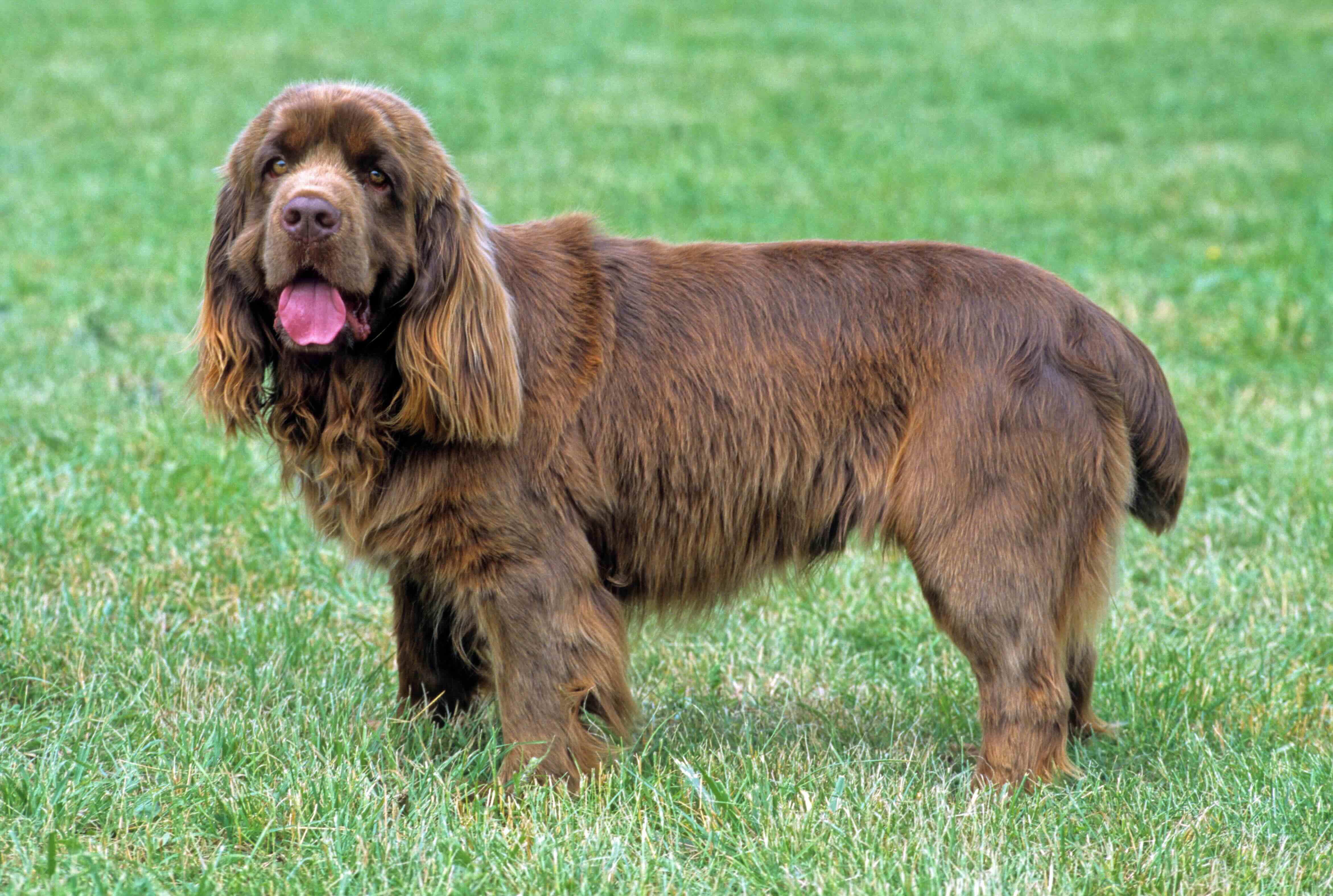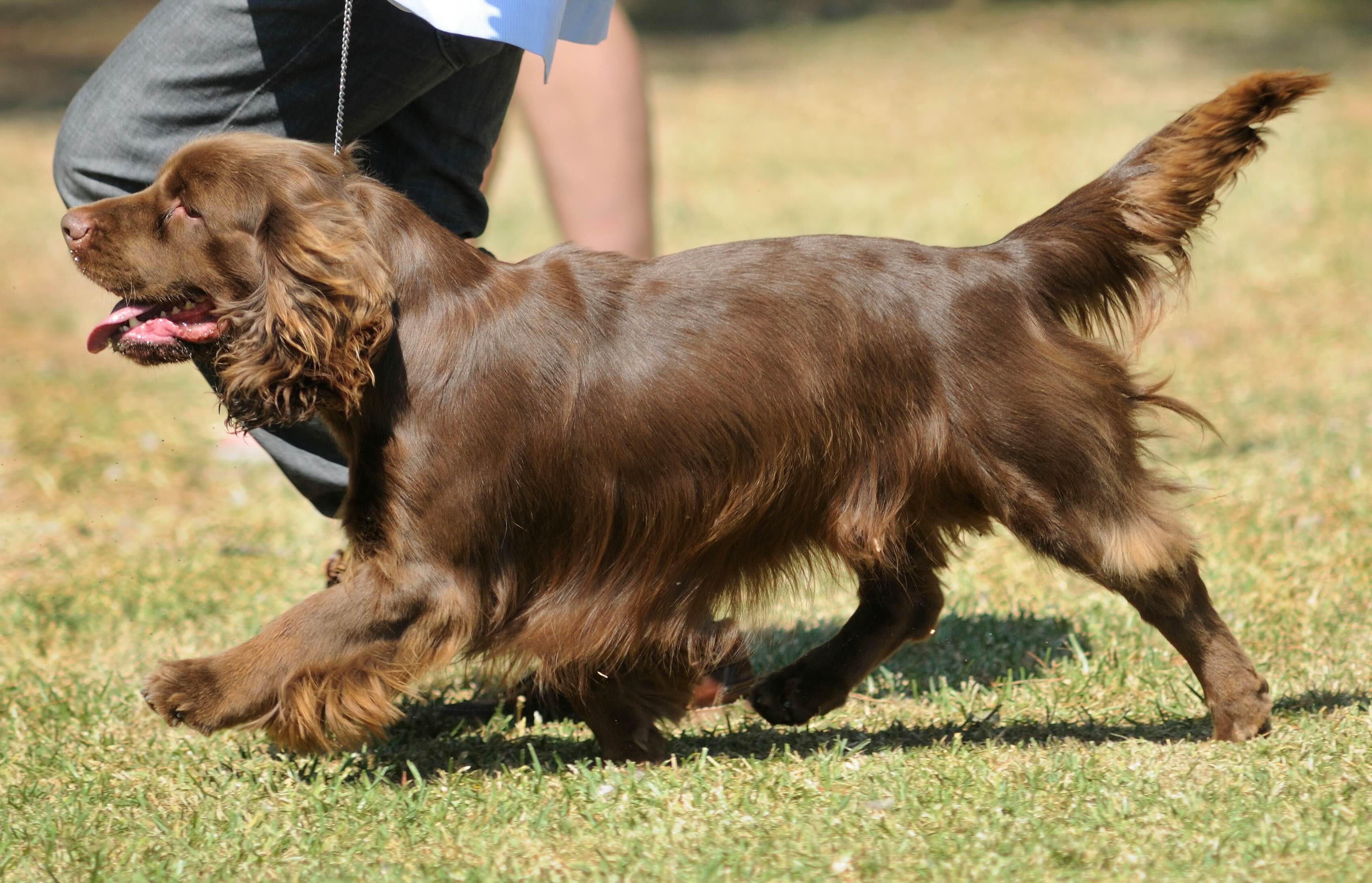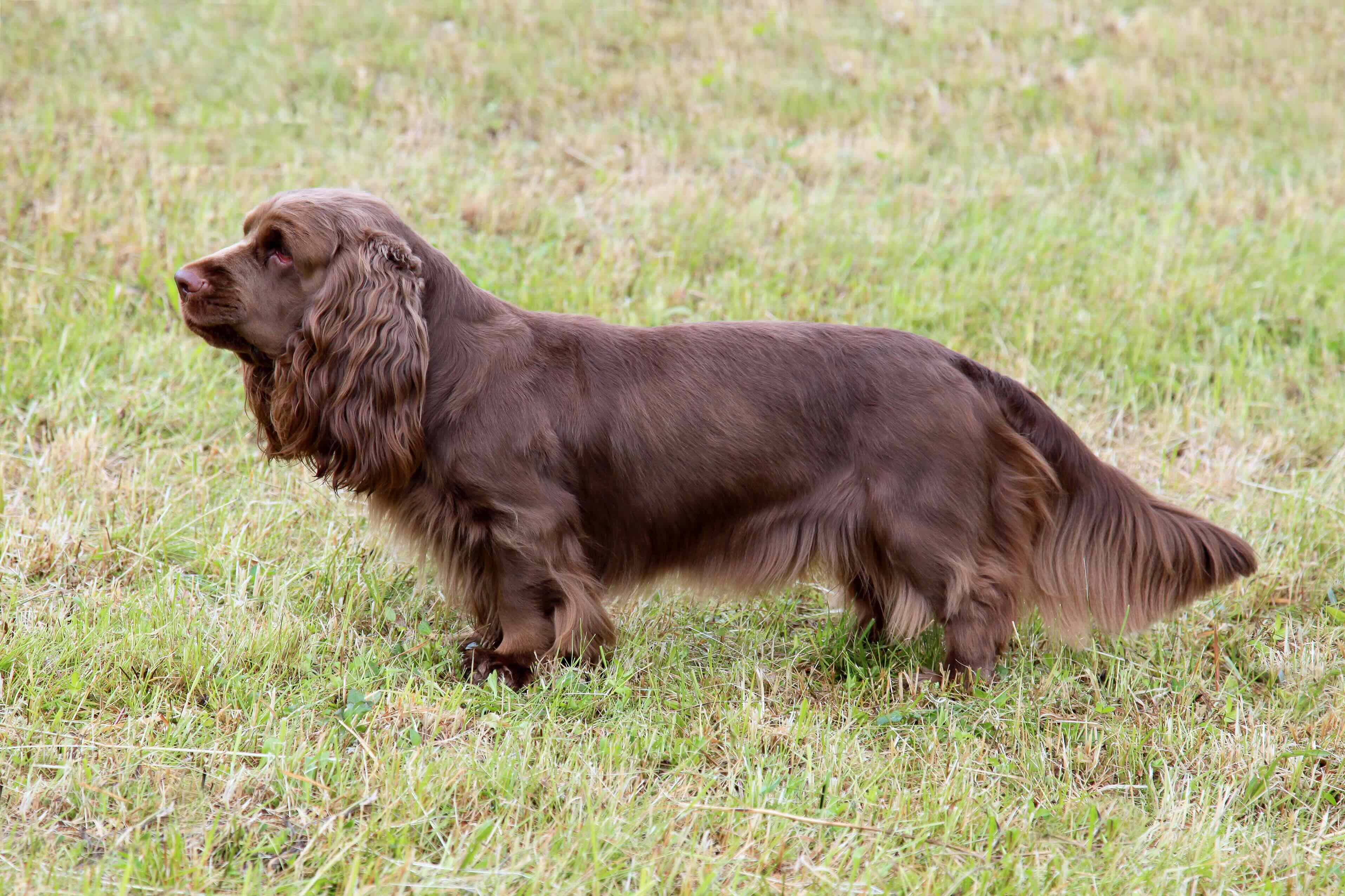The Sussex Spaniel originated in Sussex, England, where the breed starred as a field dog used to find and flush game. Today, the little brown dog is relatively rare in the U.S.
A full-grown Sussex Spaniel is 13–15 inches tall at the shoulder and weighs 35–45 pounds. These dogs are recognized by their solid, golden liver coat and blocky build; they have relatively short legs and a rectangular body, so they’re longer than they are tall.
Caring for a Sussex Spaniel
The Sussex Spaniel is a steady, friendly dog breed that’s easy to get along with, but expect these pups to be an active addition to your family. You’ll need to spend time every day exercising your spaniel and ensuring they receive mental stimulation.
Instead of being independent or aloof, Sussex Spaniels enjoy time spent with their pet parents.
“Sussex, as a whole, are very loving and like physical contact,” says Bobby Lewis, a longtime breeder and owner of Lexxfield Sussex Spaniels. Lewis says life with this breed is never lonely, and it’s not unusual for a Sussex to follow a person from room to room in a house.
Along with meeting the Sussex Spaniel’s needs for activity and interaction, you’ll need to ensure they are fed a good diet, given regular veterinary care, and receive routine attention to brushing and trimming their coat.
Sussex Spaniel Health Issues

The average Sussex Spaniel lifespan is 13–15 years, and the breed is relatively healthy. “The Sussex Spaniel is among the rarest breed of dog, yet health issues are very uncommon,” says Lewis.
Although rare, here are a few other health concerns to be aware of within the Sussex Spaniel dog breed.
Pyruvate Dehydrogenase Deficiency
This genetic disorder causes a deficiency in the PDP1 enzyme and results in a buildup of lactic acid in the body. A key symptom is exercise intolerance, but the condition can be fatal.
However, a dog DNA test can determine if a Sussex Spaniel is affected by the condition or is a carrier for the gene responsible for the condition.
Heart Problems
Occasionally, congenital or genetic heart abnormalities, such as heart disease, have been noted within the breed. The Sussex Spaniel Club of America recommends a basic cardiac exam for puppies and further testing if there is any cause for concern.
Hip and Elbow Dysplasia
Hip dysplasia is when the hip joint becomes loose, resulting in arthritis. Elbow dysplasia is similar and characterized by a loose elbow joint.
Both of these joint problems can be worsened by obesity, so it’s important to keep your Sussex Spaniel at a healthy weight. Lewis also says it’s important for Sussex Spaniel puppies to avoid intense exercise and stairs during their first year of life, as these activities can put too much stress on their joints.
Treatment depends on the condition’s severity. Mild to moderate cases can be managed with interventions such as medications, joint supplements, and weight management, but severe cases could need surgery.
How To Feed a Sussex Spaniel
A full-grown Sussex Spaniel dog will usually do best with their daily portion of food divided into two meals a day. Most pet parents feed their dog one meal in the morning and another meal in the evening.
No special dog bowls are needed, but you should make sure that both the food bowl and water bowl are washed regularly to prevent bacteria and mold growth.
How Much Should You Feed a Sussex Spaniel?
To determine how much to feed your Sussex Spaniel, start by checking the feeding guidelines on the dog food packaging. Usually, these feeding guidelines offer a suggested daily amount to feed your dog based on their weight.
You may need to adjust based on your dog’s health, activity level, and body condition score. If you’re not sure whether you’re overfeeding or underfeeding your pet, ask your veterinarian for their advice.
Nutritional Tips for Sussex Spaniels
Ask your vet about which dog supplements—if any—are specifically recommended for your pet before giving any to your Sussex Spaniel. This breed may benefit from certain joint supplements, but only at your veterinarian’s recommendation.
Typically, dogs receive all necessary nutrients from their AAFCO-compliant dog food.
Behavior and Training Tips for Sussex Spaniels
Sussex Spaniel Personality and Temperament

The Sussex Spaniel has a well-balanced temperament that makes them an excellent companion.
Lee Silensky, a Sussex Spaniel breeder and vice president of the Sussex Spaniel Club of America, describes the personality of the breed as laid-back and loving, noting that these dogs like to be by your side all the time.
However, far from being a one-person dog, the Sussex Spaniel has plenty of loyalty and affection to share. “They bond with the whole family,” says Silensky, adding that the same goes for its younger members: “They are very sensitive and gentle toward children.”
When it comes to other pets, Lewis says the Sussex Spaniel generally does fine with dogs but doesn’t necessarily long for their company. “Given a choice, I believe most Sussex would prefer to be the only pet in the house,” he says.
Early socialization and obedience training will help set your Sussex Spaniel up for success when meeting new animals. But when it comes to smaller animals, keep in mind that the breed’s prey drive could mean that they see pets like cats, rabbits, or guinea pigs as an opportunity for a game of chase.
Sussex Spaniel Behavior
The Sussex Spaniel’s even-tempered disposition means they aren’t overly prone to fear or anxiety, but they do tend to be a bit aloof toward strangers, says Lewis. The initially cool reception doesn’t last long, however, and these dogs are generally friendly and easygoing.
Keep in mind that any dog who doesn’t receive enough physical and mental exercise is more likely to exhibit restlessness or destructive behaviors, like chewing and digging.
This is true for Sussex Spaniels, too, so keep up with regular exercise and playtime. Expect to take at least one long walk a day. “The Sussex Spaniel is a sporting dog and needs exercise and activity on a daily basis; they are not couch potatoes,” says Silensky.
While the Sussex Spaniel isn’t known to be a big barker at home, these dogs are vocal while tracking game, letting out intermittent barks or yipping as they follow the scent of a bird or rabbit.
Sussex Spaniel Training
The Sussex Spaniel is generally a willing, eager-to-please dog breed. Bred to work in close cooperation with a human hunting companion, this breed is inclined to look for your cues.
These attributes make a Sussex Spaniel relatively easy to train and suitable for many first-time dog parents. Always use positive reinforcement with training treats, dog toys, and praise when training your Sussex Spaniel.
Fun Activities for Sussex Spaniels
Sussex Spaniel Grooming Guide
The Sussex Spaniel’s brown coat is soft and thick, so plan on a daily brushing and frequent baths. If you don’t mind taking care of these routine grooming needs, you’ll find the Sussex Spaniel to be a relatively easy-keeper, all things considered.
Skin Care
Typically, the Sussex Spaniel has no particular skin care requirements. Silensky recommends bathing your Sussex dog about every other week.
Coat Care
Keep a good-quality dog brush handy and give your Sussex Spaniel a daily brushing. This regular grooming will remove loose hair and reduce shedding, plus distribute oils through the coat.
Lewis says the feathering on the dog’s ears, legs, and toes is especially prone to matting, so you’ll want to be diligent about keeping those areas combed and free of debris. A pin brush is a good choice for general use on the coat, but you might reach for a slicker brush if your dog is shedding considerably or you have serious detangling to do.
In addition, you’ll want to trim your Sussex Spaniel’s fur regularly—about every other week. Silensky says trimming isn’t intense and mainly involves keeping feathering between the toes and around the feet in check. You can take your dog to a professional groomer for help.
Eye Care
As you groom your Sussex Spaniel, check their eyes for redness or discharge that might indicate an infection, and contact your veterinarian right away if you suspect a problem.
Also be watchful for any change in the appearance of your dog’s eyes—an especially droopy lower eyelid can be a sign of ectropion, which can cause your dog’s eye to become dry and irritated.
Ear Care
It’s important to keep your Sussex Spaniel’s ears clean and dry. Otherwise, their folded ears can develop an infection. If you notice odors or discharge from the ears, consult your veterinarian right away. Your vet can give you advice on how to clean your dog’s ears and which ear-cleaning product to use.
Considerations for Pet Parents

The ideal home for a Sussex Spaniel is with an active family who wants a loyal and affectionate companion for outdoor activities like hiking or hunting.
While these sporting dogs are relatively compact and aren’t known for having a super high energy level, they’re not as well-suited for apartment life. “Sussex Spaniels need a nice yard to run around in and play in,” says Silensky. “Sussex Spaniels cannot be penned up in small spaces.”
You won’t have to fuss much over their grooming, but they should be brushed daily to keep their rich brown coat looking its best. Regular exercise will keep this sturdy dog’s weight in check, and you’ll want to keep their mind active with regular training sessions and games.
If you can meet these needs and provide an abundance of affection, this little brown dog might be your ideal match.
Sussex Spaniel FAQs
Are Sussex Spaniel good pets?
Yes. Because the Sussex Spaniel is eager to please and bond with their family, this dog breed makes a very good pet for new and experienced dog parents alike.
“The breed has a calm nature that works well in most any household setting,” says Lewis.
Why are Sussex Spaniels so rare?
Compared to other popular dog breeds and even to other types of spaniels, the Sussex Spaniel is rare. These dogs are considered a preservation breed, which means breeders focus on the breed’s heritage characteristics and health rather than catering to what may be popular or in-demand for a pet.
Do Sussex Spaniels bark a lot?
Sussex Spaniels are known for barking to communicate while hunting, and they might rely on this same mode of communication to alert or engage with you in casual, everyday scenarios. That said, Sussex Spaniels don’t have a reputation for nuisance barking at home.



